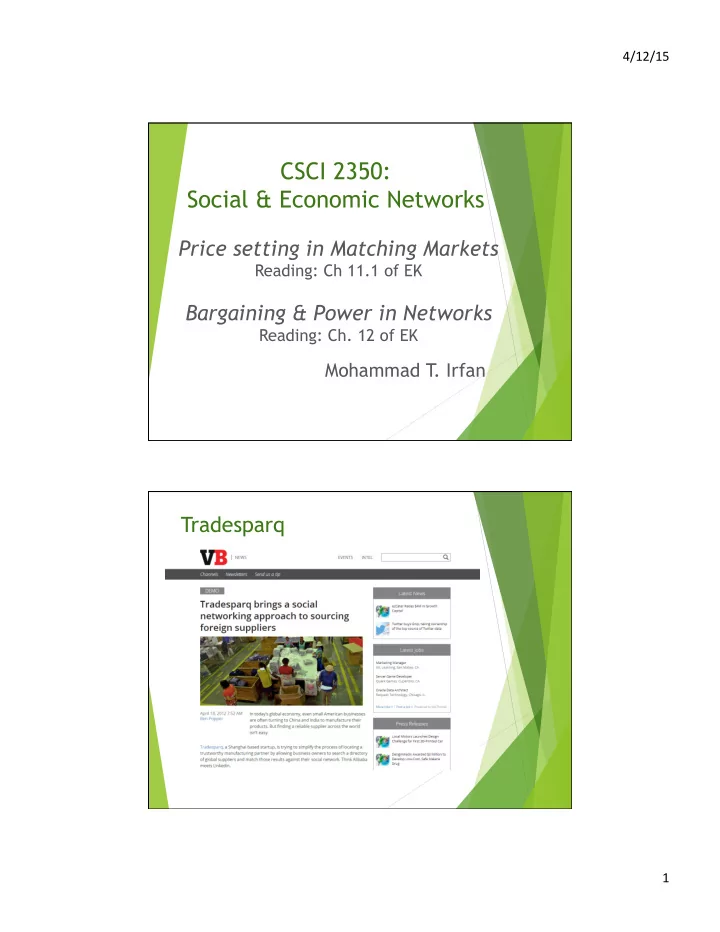

4/12/15 ¡ CSCI 2350: Social & Economic Networks Price setting in Matching Markets Reading: Ch 11.1 of EK Bargaining & Power in Networks Reading: Ch. 12 of EK Mohammad T . Irfan Tradesparq 1 ¡
4/12/15 ¡ Reminder: Market clearing price (MCP) u MCP: prices for which there exists a perfect matching in the preferred seller graph u Algorithm Initialize prices to 0 1. Buyers react by choosing their preferred seller(s) 2. If resulting graph has a perfect matching then 3. done! Otherwise, the neighbors of a constricted set increases price by 1 unit; (Normalize the prices—by decreasing all prices by the same amount so that at least one price is 0); Go to step 2 u MCP maximizes the social welfare Price-setting in real world Stock market 2 ¡
4/12/15 ¡ Stock markets u Stock exchanges – determine ~MCP u NYSE: algorithm + designated market maker (DMM) u NASDAQ: algorithm only u Trading systems – match buyers & sellers u Direct Edge, Goldman Sachs, Investment Technologies Group (ITG) Order book u 1. Limit order (big traders) u A: sell 100 shares at >= $5/share u B: sell 100 shares at >= $5.5/share u C: buy 100 shares at <= $4/share u D: buy 100 shares at <= $3.5/share 3 ¡
4/12/15 ¡ Oder book u 2. Market order (small traders) u Buy 150 shares at market price => 100 shares at $5/share and 50 shares at $5.5/share Before After Trading large volumes of shares u Hedge funds, insurance companies, mutual funds (Fidelity, Vanguard), banks, etc. trade in large volumes u 1. Split the volume into small fragments– why? u 2. Dark pool u Examples: Goldman Sach’s Sigma-X, ITG u Trade large volumes at market price without revealing identity u Accounts for 15% of US volume (2014) u Pros: Reduced impact on market, lower transaction cost u Cons: Lack of transparency, exchange prices may not reflect the real market, predatory trading by hedge funds 4 ¡
4/12/15 ¡ Bargaining & Power in Economic Networks Chapter 12 Power u Is it an individual property? u Or a result of social relations? u Richard Emerson (1962) u Social relation between two people produces “values” for them u Imbalance of values è power u Division of values: Network exchange theory 5 ¡
4/12/15 ¡ Who is most powerful? u B u Why? u Dependence: A and C completely depend on B u Exclusion: B can exclude A or C from being his “best friend” u Satiation: B will maintain relationship only if he gets a better share u Betweenness: B has the highest betweenness centrality measure u Which one is in effect? Experimental setup u A small network $1 $1 $1 $1 u Each individual is a node of the graph u Each edge contains a fixed amount of $ u Endpoints negotiate how to split that amount of $ u One-exchange rule: Each node can do transaction with at most one neighbor u Results in a matching, which may not be a perfect matching u This experiment is run for multiple rounds 6 ¡
4/12/15 ¡ Experimental results and analysis Mathematical framework Stable outcomes 7 ¡
4/12/15 ¡ Stable outcomes in network exchange u Outcome = (matching, values) u Opportunity + Incentive à unstable Stable outcomes u Limitations of stable outcomes u Extreme values u Explanation – ultimatum game u Ambiguity u Solution – Nash bargaining 8 ¡
4/12/15 ¡ Ultimatum game u Difference between real-world experimental outcomes and stable outcomes u Stable outcomes sometimes go to the extreme u Explanation u People play a different game than the one on paper! u A little dramatic here! u https://www.youtube.com/watch?v=BfE4ZL08twA 9 ¡
4/12/15 ¡ Nash bargaining solution Resolves ambiguity in stable outcomes 10 ¡
Recommend
More recommend